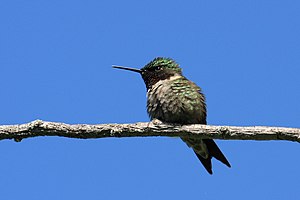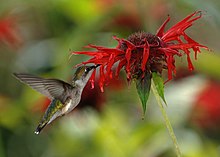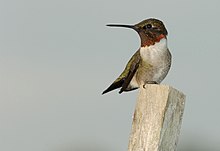Ruby-throated hummingbird
| Ruby-Throated Hummingbird | |
|---|---|

| |
| Scientific classification | |
| Kingdom: | |
| Phylum: | |
| Class: | |
| Order: | |
| Family: | |
| Genus: | |
| Species: | A. colubris
|
| Binomial name | |
| Archilochus colubris (Linnaeus, 1758)
| |

| |
| Green: summer-only range Blue: winter-only range Yellow: migratory path | |
| Synonyms | |
|
Trochilus colubris | |
The Ruby-throated Hummingbird (Archilochus colubris) is a species of hummingbird. As with all hummingbirds, this species belongs to the Trochilidae family and is currently included in the Apodiformes order. This small animal is the only species of hummingbird that regularly nests east of the Mississippi River in North America.
Description

The Ruby-throated Hummingbird is the smallest bird species that breeds in the Eastern United States and Eastern Canada, though is a roughly medium-sized species by hummingbird standards. This hummingbird is from 7 to 9 cm (2.8 to 3.5 in) long and has a 8 to 11 cm (3.1 to 4.3 in) wingspan. Weight can range from 2 to 6 g (0.071 to 0.212 oz), with males averaging 3.4 g (0.12 oz) against the slightly larger female which averages 3.8 g (0.13 oz).[3][4] Adults are metallic green above and greyish white below, with near-black wings. Their bill, at up to 2 cm (0.79 in), is long, straight and very slender. As in all hummingbirds, the toes and feet of this species are quite small, with a middle toe of around 0.6 cm (0.24 in) and a tarsus of approximately 0.4 cm (0.16 in). The Ruby-throated Hummingbird can only shuffle if it wants to move along a branch, though it can scratch its head and neck with its feet.[5][6]
The species is sexually dimorphic.[7] The adult male, shown in the photo, has a ruby red throat patch (also known as a gorget) which may appear black in some lighting, and a dark forked tail. The female has a dark rounded tail with white tips and generally no throat patch, though she may sometimes have a light or whitish throat patch. The male is smaller than the female, and has a slightly shorter beak. A molt of feathers occurs once a year, and begins during the autumn migration.
Habitat and range


The breeding habitat is throughout most of eastern North America and the Canadian prairies, in deciduous and pine forests and forest edges, orchards, and gardens. The female builds a nest in a protected location in a shrub or a tree. Of all North American hummingbirds, this species has the largest breeding range.[5]
The Ruby-Throated Hummingbird is migratory, spending most of the winter in southern Mexico, Central America as far south as South America[citation needed], and the West Indies. It breeds throughout the eastern United States, east of the 100th meridian, and in southern Canada in eastern and mixed deciduous forest.[8] In winter, it is seen mostly in Mexico.
Behavior
Ruby-throated hummingbirds are solitary. Adults of this species are not social, other than during courtship (which lasts a few minutes); the female also cares for her offspring. Both males and females of any age are aggressive towards other hummingbirds. They may defend territories, such as a feeding territory, attacking and chasing other hummingbirds that enter. In late summer to early fall they fatten up for migration. This is important because, as part of their migration, they must fly across the Gulf of Mexico. This feat is impressive, as a 500-mile, non-stop flight over water would seemingly require a caloric energy that far exceeds an adult hummingbird's body weight of 3 grams. However, researchers discovered the tiny birds can increase their body mass up to double with lean mass in preparation for their Gulf crossing. The additional mass, stored as fat, provides enough energy for the birds to achieve the flight.
They feed frequently while active during the day. When temperatures drop, particularly on cold nights, they may conserve energy by entering hypothermic torpor.
Flight
Hummingbirds have many skeletal and flight muscle adaptations which allow the bird great agility in flight. Muscles make up 25-30% of their body weight, and they have long, blade-like wings that, unlike the wings of other birds, connect to the body only from the shoulder joint. This adaptation allows the wing to rotate almost 180°, enabling the bird to fly not only forward but fly backwards, and to hover in front of flowers as it feeds on nectar, or hovers mid-air to catch tiny insects. Hummingbirds are the only known birds that can fly backwards.
During hovering, (and likely other modes of flight) ruby-throated hummingbird wings beat 55 times per second.
Diet

Nectar from flowers and flowering trees, as well as small insects and spiders, are its main food. Although hummingbirds are well known to feed on nectar, small arthropods are also an important part of adult hummingbirds' diet. Arthropods appear to be the main source of protein, minerals, vitamins, providing a protein source since. Their diet may also occasionally include tree sap taken from sapsucker wells. Hummingbirds show a slight preference for red, tubular flowers as a nectar source. The birds feed from flowers using a long extendendable tongue, and catch insects on the wing or glean them from flowers, leaves, bark, and even from spider's webs.
Young birds are fed insects for protein since nectar is an insufficient source of protein for the growing birds.[9]
Reproduction

Ruby-throated hummingbirds are thought to be polygynous. Polyandry and polygynandry may also occur. They do not form breeding pairs, with males departing immediately after the reproductive act and females provide all parental care.[10]
Males arrive at the breeding area in the spring, and establish a territory before the females arrive. When the females return, males court females that enter their territory by performing courtship displays. They perform a “dive display” rising 8 – 10 feet above and 5 – 6 feet to each side of the female. If the female perches, the male begins flying in very rapid horizontal arcs less than 0.5 m in front of her.
If the female is receptive to the male, she may give a call and assume a solicitous posture with her tail feathers cocked and her wings drooped.
The nest is usually constructed on a small, downward-sloping tree limb 3.1 to 12.2 m (10 to 40 ft) feet above the ground. Favored trees are usually deciduous, such as oak, hornbeam, birch, poplar or hackberry, although pines have also been used. Nests have even been found on loops of chain, wire, and extension cords.[5] The nest is composed of bud scales, with lichen on the exterior, bound with spider's silk, and lined with plant down (often dandelion or thistle down). Most nests are well camouflaged. Old nests may be occupied for several seasons, but are repaired annually [citation needed]. The female constructs the nest, as the male has left by this point.
Females lay two (with a range of 1 to 3) white eggs about 12.9 mm × 8.5 mm (0.51 in × 0.33 in) in size, and produce one to two broods each summer.[5] They brood the chicks over a period of 12 to 14 days. The female feeds the chicks from 1 to 3 times every hour by regurgitation, usually while the female continues hovering. When they are 22 to 25 days old, the young leave the nest and make their first flight.
Longevity and mortality
The oldest known Ruby-throated Hummingbird to be banded was 9 years and 1 month of age. Almost all hummingbirds of 7 years or more in age are females, with males rarely surviving past 5 years of age. Reasons for higher mortality in males may include loss of weight during the breeding season due to the high energetic demands of defending a territory followed by energetically costly migration. There are several small animals who prey on these hummingbirds given the opportunity. Due to their small size, they are vulnerable even to birds and other animals which generally feed on insects. Chief among their predators are Sharp-shinned Hawks, domestic cats and loggerhead shrikes, all of which are likely to ambush the hummingbird while it sits on a perch. Bird-eating lizards and snakes may also prey on the species, especially on its subtropical wintering grounds. Also largemouth bass, bullfrogs and green frogs have reportedly grabbed hummingbirds when they've attempted to go for a drink, despite their swift flying speeds. Even large, predaceous invertebrates have preyed on Ruby-throated Hummingbirds, including praying mantises, orb-weaving spiders and Green Darners. Blue jays are common predators of nests.[11][12][13]

Vocalization
The vocalizations of Ruby-throated Hummingbirds are rapid, squeaky chirps, and are used primarily for threats. For example, males may vocalize to warn another male that has entered his territory.
During the courtship displays, the male makes a rapid tik-tik tik-tik tik-tik sound, apparently with his wings. The sound is produced both during the shuttle display, at each end of the side-to-side flight. Also, the sound is made during dive displays. A second, rather faint, repeated whining sound is sometimes produced with the outer tail-feathers during the dive, as the male flies over the female, spreading and shutting the tail as he does so.
References
- ^ Template:IUCN
- ^ "Ruby-throated Hummingbird". All About Birds. Retrieved 13 June 2011.
- ^ Kirschbaum, Kari. "ADW: Archilochus colubris: INFORMATION". Animaldiversity.ummz.umich.edu. Retrieved 7 November 2012.
- ^ "Ruby-throated Hummingbird, Life History, All About Birds - Cornell Lab of Ornithology". Allaboutbirds.org. Retrieved 7 November 2012.
- ^ a b c d "Ruby-throated Hummingbird, Life History, All About Birds - Cornell Lab of Ornithology". Allaboutbirds.org. Retrieved 7 November 2012.
- ^ "John James Audubon's Description of the Ruby-throated Hummingbird". Rubythroat.org. Retrieved 7 November 2012.
- ^ "Hummingbird: external appearance, ageing, sexing". Ruby-Throat.org. Retrieved 13 June 2011.
- ^ Harris, M. "Archilochus colubris". University of Michigan Museum of Zoology. Retrieved 24 August 2007.
{{cite web}}: Unknown parameter|coauthors=ignored (|author=suggested) (help) - ^ Robinson, T. R., R. R. Sargent, and M. B. Sargent. 1996.
- ^ Lanny Chambers. "Ruby-throated Hummingbird". Hummingbirds.net. Retrieved 13 June 2011.
- ^ Kirschbaum, Kari. "ADW: Archilochus colubris: INFORMATION". Animaldiversity.ummz.umich.edu. Retrieved 7 November 2012.
- ^ "Hummingbirds: Predators 1". Rubythroat.org. Retrieved 7 November 2012.
- ^ "Praying Mantis Makes Meal of a Hummingbird | Bird Watcher's Digest". Birdwatchersdigest.com. Retrieved 7 November 2012.
- Interesting Ruby-throated Hummingbird Facts donated by BirdHouses101.com
- data collected from fall migrating Ruby-throated hummingbirds along coastal South Carolina, communications with researchers along the US southeastern and Gulf coasts.
External links
- Tracking Migration/Journey North
- Ruby-throated Hummingbird Nest Images (Day-by-Day)
- Ruby-throated Hummingbird Nest Cycle
- Ruby-throated Hummingbird - Cornell Lab of Ornithology
- Ruby-throated Hummingbird Information - USGS Patuxent Bird Identification InfoCenter
- Ruby-throated hummingbird at feeder (animation)
- Operation RubyThroat: The Hummingbird Project
- photographs of this and other hummingbird species
- All about the Ruby-throated Hummingbird
- How to Photograph Hummingbirds - including many photos of this species
- migration map (US and Canada only)
- 2007 spring migration
- Stamps
- Ruby-throated Hummingbird videos on the Internet Bird Collection
- Videos of Ruby Throated Hummingbirds
- Research project on the Ruby-throated hummingbird in Québec
- Ruby-throated Hummingbird Migration Map Archives (2002-present)


